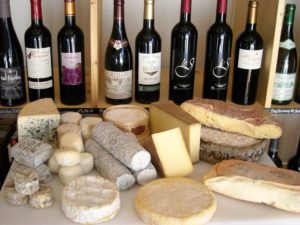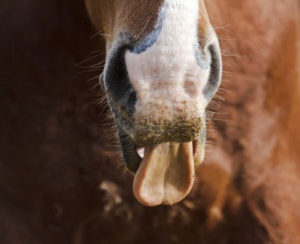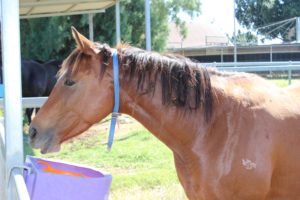European Workshop for Equine Nutrition 2016 (Part 1)
 Founder of MB Equine Services, Mariette van den Berg, travelled in June to Europe to attend two very special equine science conferences – the European Workshop on Equine Nutrition (EWEN) and the International Society for Equitation Science (ISES) Conference.
Founder of MB Equine Services, Mariette van den Berg, travelled in June to Europe to attend two very special equine science conferences – the European Workshop on Equine Nutrition (EWEN) and the International Society for Equitation Science (ISES) Conference.
At both these conferences, Mariette presented results from her PhD project that focuses on behavioural mechanisms of diet selection by horses. In this new series, she will be featuring a selection of interesting topics and findings from her own project, and other researchers who attended the 8th bi-annual EWEN, which was held in Dijon, France.
The bi-annual European Workshop on Equine Nutrition was first held in 2002 in Dijon and, after 2004, has been touring through Europe, visiting Italy in 2006, Finland in 2008, the United Kingdom in 2010, Portugal in 2012 and Germany in 2014, before returning again to France this year.
EWEN is recognised as Europe’s leading scientific event in equine nutrition, and brings European and international scientists together to share scientific information, disseminate technical expertise amongst the wider horse industry and foster innovation. Each conference has a theme and this year EWEN 2016 was entitled ‘Taste, Nutrition and Health of the Horse’.
 This focus was chosen because of the location, which is home to the Centre for Taste, Food and Nutrition Sciences (CSGA). Of course, Dijon is also very conveniently located in the Burgundy region, which is famous for its wine and great cheeses!
This focus was chosen because of the location, which is home to the Centre for Taste, Food and Nutrition Sciences (CSGA). Of course, Dijon is also very conveniently located in the Burgundy region, which is famous for its wine and great cheeses!
‘Taste’ is a conference topic which has not been studied extensively in horses and is very applicable to my PhD project, which investigated factors that influence foraging behaviour and diet selection in horses, with a main focus on orosensory (smell, taste, texture) and post-ingestive (nutrients) feedback mechanisms.
This month, I present a summary of two presentations, the first is one of my presentations that described some of the findings from our peer reviewed paper entitled ‘Influence of odour, taste and nutrients on feeding behaviour and food preferences in horses’. This full study has been recently published in the Applied Animal Behaviour Science Journal, which you can access here. The second is a fascinating study aimed at finding alternative wormers to fight the alarming resistance parasites are developing to anthelmitic drugs and tested plant secondary compounds.
1. Effect of flavours and odours on diet intake in horses
In one of our earlier studies that examined the acceptance of nutritious novel forages, we had observed horses almost invariably consume only small quantities of food when it is presented for the first time (van den Berg et al., 2016a). The cautious sampling of new food types is referred to as neophobia (‘fear of new’) and has been suggested as an innate herbivore survival mechanism for avoiding the over-consumption of toxic plants in the wild (Provenza and Balph, 1988).
 While feed neophobia is usually described in horses as “fussy eaters”, similar behaviour occurs in many animal species, including humans! Commercial horse feed manufacturers commonly use flavours to overcome this feed neophobia, but there are limited studies that have investigated how well horses accept these flavours.
While feed neophobia is usually described in horses as “fussy eaters”, similar behaviour occurs in many animal species, including humans! Commercial horse feed manufacturers commonly use flavours to overcome this feed neophobia, but there are limited studies that have investigated how well horses accept these flavours.
Flavours have been added to encourage the intake of water, unpalatable anthelmintic drugs (wormers), as well as concentrates and supplements with different effects. For example, a study by Burton et al. (1983) used apple, lucerne, caramel and anise-molasses to mask the drugs levamisol and piperazine in a concentrate diet, and showed only apple, lucerne and caramel were partially effective, not anise-molasses.
Goodwin et al. (2005a) examined the effect of 15 food flavours on concentrate selection by stabled horses and showed the two most preferred flavours (fenugreek and banana) could be used to encourage the intake of an unpalatable mineral pellet. However, the characteristics of what flavours are most useful have not been well defined.
For example, flavours can be classified as non-nutritive, providing only an aromatic and/or non-caloric taste (artificial or natural sweetener), or nutritive, which can include an aromatic and/or taste that contains calories.
In another study, Goodwin et al. (2005b) reported in multiple choice trials and in the short term, horses can respond to sensory variety in concentrate diets that differ in flavours (odour and caloric taste) and/or formulations (nutrients), and they select from preferred and less preferred food choices.
Nevertheless, it was still unclear how horses respond to non-nutritive flavour changes over a longer period when they are presented with a single diet. This is why, as part of a larger study and over a period of four weeks, we examined the responses to flavour (odour) changes on diet intake. Our main objective was to assess the diet/odour acceptance and variability in intake after each diet/odour introduction was made.
In our study, we offered four fibre pellet diets to 16 adult horses. These diets were similar in digestible energy, but differed in crude protein (CP) levels (Low CP; 14% and High CP; 27%), with one of these levels including a non-caloric natural sweetener + taste.
 The four diets (LP, LP+, HP and HP+) were presented in the order from low to high palatability over four weeks (five days on each diet) and were linked to four non-caloric odours (spearmint, banana, cinnamon and coconut).
The four diets (LP, LP+, HP and HP+) were presented in the order from low to high palatability over four weeks (five days on each diet) and were linked to four non-caloric odours (spearmint, banana, cinnamon and coconut).
These four odours were chosen from different flavour classes (i.e. nut flavour, fruit flavour, spice flavour and herb flavour) to avoid similar characteristics and confuse horses. The aim of the adaptation phase was to allow horses to learn about the flavour-to-post-ingestive associations of each diet – this was important for later preference testing and diet ranking.
To make sure all diets and odour combinations were tested, the horses were divided into four groups, which allowed for randomisation of the odours to the four diets (Latin Square 4 x 4). This meant each group received its own unique odour-diet combinations throughout the adaptation phase and during further preference testing.
The odours were sprayed onto the feed before being presented to the horses. Horses were offered 400g per diet/day. The intake was recorded daily and calculated to proportions consumed out of the total food offered.
Our results showed with each introduction of a new odour/diet, an initially large variation in intake was recorded, with some horses showing a neophobic response, while others exhibited no apparent recognition of the odour being new.
Individual variability reduced within 3-4 days for all four odours, with horses consuming between 80-100% of the diet.
 This adaptation of 3-4 days to new diet / odour was also observed in our previous study (van den Berg et al., 2016b); suggesting odour cues can have a strong initial influence on feed intake by horses and highlights the important role of smell in diet selection.
This adaptation of 3-4 days to new diet / odour was also observed in our previous study (van den Berg et al., 2016b); suggesting odour cues can have a strong initial influence on feed intake by horses and highlights the important role of smell in diet selection.
Even so, we conclude that non-nutritive odours can be safely introduced to equine diets without upsetting intake patterns for prolonged periods of time. In addition, once horses are familiar with specific odours (that are linked to well-liked diets), you can use this odour as a cue to ease the transition from familiar food to more novel or less palatable foods.
References
- Burton J.H., Price D.J. and Aspinal J. 1983. The effect of feed flavour and feed consumption in horses. In Eight Equine Nutrition and Physiology Symposium Lexington, KY, USA.
- Goodwin D., Davidson H.P.B. and Harris P. 2005a. Selection and acceptance of flavours in concentrate diets for stabled horses. Applied Animal Behaviour Science 95, 223-232.
- Goodwin D., Davidson H.P.B. and Harris P. 2005b. Sensory varieties in concentrate diets for stabled horses: effects on behaviour and selection. Applied Animal Behaviour Science 90, 337-349.
- Provenza F.D. and Balph D.F. 1988. Development of dietary choice in livestock on rangelands and it’s implications for management. Journal of Animal Science 66, 2356-2368.
- van den Berg M., Lee C., Brown W.Y. and Hinch G.N. 2016a. Does energy intake influence diet selection of novel forages by horses? Livestock Science 186, 6-15.
- van den Berg M., Lee C., Brown W.Y., Giagos V. and Hinch G.N. 2016b. Acceptance of novel food by horses: the influence of food cues and nutrient composition. Applied Animal Behaviour Science, 183, 59-67.
Research Update: Foraging behaviour in horses
 You may remember that last year we conducted a national horse forage survey for my PhD research at the University of New England. This survey was the first part of the study to collect information about foraging behaviour and diet selection of pastured domestic horses in Australia.
You may remember that last year we conducted a national horse forage survey for my PhD research at the University of New England. This survey was the first part of the study to collect information about foraging behaviour and diet selection of pastured domestic horses in Australia.
This was necessary because diet selection of fresh forages has been primarily studied in wild or free-roaming horses. Very little work has been done that looked into the diet selection of pastured horses and particular the selection of vegetation other than grasses and legumes is not documented.
In addition, we wanted to gain more insight in the pasture conditions of grazing areas, feeding management and the occurrence of unusual behaviours of horses at pasture. The data has been analysed and is now in a final draft to be reviewed and submitted to a peer reviewed journal. We hope later this year to provide a link to the official published paper and we will feature a summary of the results in the Horses and People and Hoofbeats Magazine. So stay tuned!
The next step in this research is to gain a better understanding of the motivations of selecting a wide range of forages by horses. We are aware that herbivores select a variety of plants to cover their nutritional requirements but there is also a complex feedback mechanism – so called post ingestive feedback – that is involved. Animals can get satiated on the plants they select (due to flavour or nutrients) or there may be secondary compounds that are getting to excessive and so animals may need to switch to another plant source. There are many other factors that will influence diet selection of herbivores. Only limited research has been conducted with horses, so my research will focus on getting a better insight in some of these aspects for horses.
One of the first task was collecting some novel/alternative forages for horses. Finally after 5 months we finished the collection of tree/shrub forage for the first trial. We collected between 70- 100 kg of fresh weight of Tagasaste, Bamboo and Willow leaves! Just to get about 30 kg of dried and chaffed material. The other fodder Saltbush and Moringa are already ready for us.

Now we can focus on the next stage – which is getting ready for the actual forage trial with the horses. We are interested to look at novel and familiar forages and bunch of other things that I am hoping to get more insight in! Re-visit our website/blog and/or like our MB Equine Services Facebook page to get the latest updates on this research project and other educational events such as workshops or article releases.
Mariette
Research Alternative Forages for Horses
 In 2012 I started my PhD project at the University of New England. The main focus of my study is patch foraging behaviour, particular browsing behaviour, in horses and the use of fodder trees and shrubs as forage enrichment for domesticated horses in Australia. This research will help the horse industry to better understand the potential use of alternative and suitable forage sources and the affect of forage enrichment on the behaviour of horses in intensive equine management systems.
In 2012 I started my PhD project at the University of New England. The main focus of my study is patch foraging behaviour, particular browsing behaviour, in horses and the use of fodder trees and shrubs as forage enrichment for domesticated horses in Australia. This research will help the horse industry to better understand the potential use of alternative and suitable forage sources and the affect of forage enrichment on the behaviour of horses in intensive equine management systems.
Patch foraging behaviour and animal welfare
Why this interest in patch foraging behaviour? I believe that the ability to browse on a range of trees, shrubs, herbaceous plants, roots and mosses might be important for the health and well-being of horses.
In 2009, I moved to Australia from The Netherlands and founded MB Equine Services, which provides specialised equine nutrition and horse property design and pasture management. “Designing pasture systems is part of the business,” I started to investigate the role of alternative forage sources as a drought reserve. And a bit of research made me realise that, in nature, horses browse a lot.
This raised the question: ‘How do domesticated horses cope with an enclosed environment in which there is no – or limited – access to browsing?’ Is there something in browsing that might be important for their nutrient balance or gut and dental health?”
I hope to provide some answers to these questions in my research towards a doctoral degree at UNE. “We don’t often provide our horses with the alternative foods that – in nature – are a large part of their diet,” Variety is the spice of life for herbivores – whether they are confined, or foraging on pastures or rangelands – as well as for people. Like us, they are periodically satiated by familiarity and thrive on variety.
We keep horses in a stable or a paddock without feeling obliged to enrich their lives – and edible enrichment has been shown to be the best sort. Such enrichment could address problems of abnormal behaviour and help to avoid ulcers and dental problems.”
Farmers know that planting shrubs and trees on their properties has a range of environmental and agricultural benefits, and this possible advantage for their horses could add to that list of benefits.
Research
The first stage of the research program was a survey. You may have seen it advertised or may have even participated! If so, thank you for your contribution. This survey allowed us to collect data on how horses are managed and identify if browsing is a common behaviour in domesticated horses in Australia. I am currently conducting the data analysis and writing it up for a journal publication.
The next step is to investigate some of the questions why horses select a variety of foods and when they are more likely to ingest novel and familiar foods. The novel foods will be browse fodder. To be able to answer these questions we will conduct non-invasive preference tests with horses. We will record their behaviour by video recording. The first experiment will hopefully run later this year.
So for now I am working with novel forages, collecting browse from a variety of trees and shrubs and drying them. We need a lot of fresh browse to make a chaff. So over the coming months we will collect these forages so we can dry and chaff them for our testing. I am very curious how the horses will respond.

Keep checking our website and FB page for updates! I hope later this year to give you more information about the publication of the survey and progress of the research.
Australian Horse Keeping Conference 2012
Living Legends Melbourne 12 /13 Nov 2012
 Horse owners talk about weeds, dust, mud and emerging diseases. Scientists and natural resource managers talk about water quality, biodiversity and climate impacts. Yet we are all talking about the same thing.
Horse owners talk about weeds, dust, mud and emerging diseases. Scientists and natural resource managers talk about water quality, biodiversity and climate impacts. Yet we are all talking about the same thing.
The aim of this event is to bring a variety of people together to exchange knowledge about sustainable horse keeping practices from the researcher “down” and grass roots “up”!
MB Equine Services will be hosting a presentation on forages and enrichment for horses.
Confirmed Speakers:
Alayne Blickle (USA) http://www.horsesforcleanwater.com/
Jane Myers http://www.equiculture.com.au/
Dr Gary Muscatello http://piarn.org.au / http://sydney.edu.au/vetscience/about/staff/profiles/gary.muscatello.276.php
Mariette van den Berg www.mberg.com.au
Dr Kirrilly Thompson http://tinyurl.com/kirrilly-thompson
Dr Andrew Clarke www.livinglegends.com.au
Target Audiences: Horse owners, horse property managers, NRM & Local Government Officers. Educators, lecturers, coaches, equine & racing students & LandCare leaders involved with typical peri-urban small horse keeping properties or commercial horse keeping enterprises.
Day 1: will feature all speakers. Day 2: Alayne Blickle
$110 per day including catering / $88 per day for Horse SA members
Monday night optional gourmet BBQ tea & 2.5 hr. drinks package avail. Guests of delegates welcome to BBQ. Includes tour of Living Legends property.
REGISTER HERE: http://www.trybooking.com/BCDX
Sponsorship and promotional opportunities are available: Enq. horsesa@horsesa.asn.au or hw@senet.com.au
Thank you to the following sponsors for assisting this important event to be put on:
Primary Industries Adaptation Research Network
Central Queensland University Appleton Institute

Curious horses
 This week we started the forage pilot study, which is part of a honours students practical research work. Its only a small preference trial, but it will provide us with some valuable information for our later studies.
This week we started the forage pilot study, which is part of a honours students practical research work. Its only a small preference trial, but it will provide us with some valuable information for our later studies.
For this trial the student has to visit a number of horse properties and this week we started with the first two properties. The weather had been dry for the last 6 weeks but on the day that we wanted to start the trial – of course they predicted rain! So day 2 of the trial we spend most of the time in the rain with the horses. Nevertheless, the horses preformed even in the rain and showed their normal curiosity to all the visitors and foods we brought in!


Follow Us!